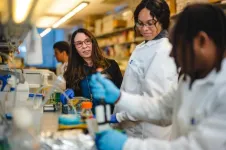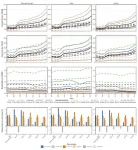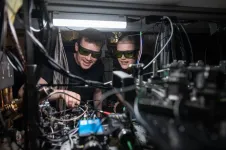PHILADELPHIA — (February 5, 2025) —The lab of The Wistar Institute’s Jessie Villanueva, Ph.D., has identified a new strategy for attacking treatment-resistant melanoma: inhibiting the gene S6K2. The team published their findings in the paper, “Selective abrogation of S6K2 identifies lipid homeostasis as a survival vulnerability in MAPKi-resistant NRASMUT melanoma,” from the journal Science Translational Medicine.
“This work shows that, even in the face of notoriously treatment-resistant melanoma, targeting S6K2 is a viable strategy for improving therapeutic outcomes,” said Dr. Villanueva, associate professor in Wistar’s Ellen and Ronald Caplan Cancer Center. “We’re excited to see where further research will lead us in the continued fight to reduce deaths from melanoma.”
Melanoma is the deadliest skin cancer, and it is also on the rise. Since 2000, the number of melanoma cases per 100,000 Americans has increased from roughly 18 to 24, which scientists suspect to be at least partially caused by increased exposure to UV radiation from sources like time spent without protection in sunlight or the use of tanning beds. In general, cancer tends to be a disease correlated with age, but melanoma is notable as one of the most common cancers diagnosed in people under 30, with cases on the rise in that age cohort as well. Although significant progress has been made in treating melanoma, drug resistance remains a daunting challenge, and many patients do not respond to current treatments.
As part of The Wistar Institute’s Melanoma Research Center, the Villanueva lab pursues new ways to overcome the challenge of melanoma drug resistance. In this paper, the group took aim at melanomas with a mutation in the NRAS gene (abbreviated as NRASMUT melanoma).
NRASMUT melanoma accounts for about 30% of all melanoma cases, which has made it a priority of melanoma researchers. Previous research has indicated that MAPK inhibitors could be a potential therapy for NRASMUT melanoma. However, on their own, MAPK inhibitors fail in about 80% of cases and don’t extend patient survival with any significant improvement.
By analyzing the downstream molecular and genetic impact of MAPK inhibition in NRASMUT melanomas, the Villanueva team identified the gene S6K2 as a possible target. Once they assessed melanoma patient data, Dr. Villanueva and lab found that expression of S6K2 was correlated with worse patient outcomes, and MAPK-treatment resistance in patients with NRASMUT melanoma.
The team tested their hypothesis in the lab by silencing the S6K2 gene, which successfully killed NRASMUT melanoma cell lines known to resist MAPK inhibition. Further analysis revealed that S6K2 inhibition killed these cancer cells by disrupting an important lipid metabolism process.
The Villanueva lab’s discovery of S6K2 inhibition’s anti-melanoma potential also led to their identification of yet another angle of attack against melanoma resistant to treatment with MAPK inhibition. When they silenced S6K2, the team noticed that it had an effect on another gene called PPARα. After refining their understanding of PPARα’s effects on NRASMUT melanomas, the researchers capitalized on this finding by using a combination treatment of two compounds, fenofibrate (which activates PPARα) and DHA (also known as Omega-3), to successfully induced cell death in melanomas that were known to resist treatment with MAPK inhibitors.
“Our findings suggest a clear path forward for more preclinical research on these treatment options,” said co-first author, Brittany Lipchick, Ph.D., associate staff scientist in the Villanueva lab. “Not only did our treatments work in the lab — they also appear to be quite safe. Some of the drugs we tested, like fenofibrate, are already safely used in humans for other purposes, so the road ahead is well-lit.”
Fellow co-first author Adam Guterres, Ph.D., Villanueva lab associate staff scientist, agreed: “Before this paper, we knew that certain treatments could theoretically work against melanomas that resist treatment with MAPK inhibitors, but they were a non-starter because they were incredibly toxic. Our work shows that we can still fight this stubborn melanoma without a prohibitively toxic treatment, which is exciting news for where this work takes us.”
Co-authors: Brittany Lipchick1, Adam N. Guterres1, Hsin-Yi Chen1, Delaine M. Zundell1, Segundo Del Aguila1, Patricia I. Reyes-Uribe1, Yulissa Tirado1, Subhasree Basu1, Xiangfan Yin1, Andrew V. Kossenkov1, Yiling Lu2, Gordon B. Mills3, Qin Liu1, Aaron R. Goldman1, Maureen E. Murphy1, David W. Speicher1, and Jessie Villanueva1
1The Wistar Institute, Philadelphia, Pennsylvania 19104
2The University of Texas MD Anderson Cancer Center
3Knight Cancer Institute, Oregon Health & Sciences University
Work supported by: This work was supported by National Institutes of Health grants P30CA010815, S10OD023586S10, CA016672, P01CA114046, P50CA174523, R01CA268510, U54CA224070, T32GM008275, and T32CA009171; Department of Defense grant HT94252310914; and Pennsylvania Department of Health SAP# 4100083104. Additional funding support was provided by Dr. Miriam and Sheldon G. Adelson Medical Research Foundation, The Melanoma Research Alliance, the V Foundation for Cancer Research, The Wistar Science Accelerator Award, and The Goldblum Family Healthcare Fund.
Publication information: “Selective abrogation of S6K2 maps lipid homeostasis as a survival vulnerability in MAPKi-resistant NRASMUT melanoma,” from Science Translational Medicine.
ABOUT THE WISTAR INSTITUTE
The Wistar Institute is the nation’s first independent nonprofit institution devoted exclusively to foundational biomedical research and training. Since 1972, the Institute has held National Cancer Institute (NCI)-designated Cancer Center status. Through a culture and commitment to biomedical collaboration and innovation, Wistar science leads to breakthrough early-stage discoveries and life science sector start-ups. Wistar scientists are dedicated to solving some of the world’s most challenging problems in the field of cancer and immunology, advancing human health through early-stage discovery and training the next generation of biomedical researchers. wistar.org.
END


